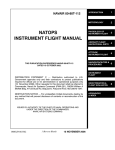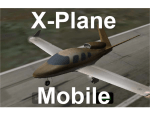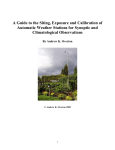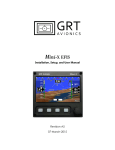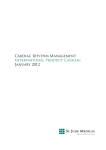Download Pass Your Private Pilot Checkride
Transcript
www.MzeroA.com 1 Visit Outer Marker Publishing!s interactive website for more great titles at www.outermarkerpublishing.com Pass Your Private Pilot Checkride Copyright © 2011 by Jason Schappert All Rights Reserved Cover Photo Copyright © 2010 by Blair McFarlain All Rights Reserved Unless Otherwise Indicated All Images © 2011 by Jason Schappert All Rights Reserved Proudly Printed In The United States of America $39.95 US / $49.95 CAN Aviation / Flight Training Outer Marker Publishing Ocala, FL OuterMarkerPublishing.com www.MzeroA.com 2 To my parents who helped me dream big. To my beautiful bride who helped me achieve those dreams. Jason Schappert www.MzeroA.com 3 Acknowledgments! 16 About the Author and About This Book! 17 A Personal Note From Jason! Chapter 1: Know Your Certificates and Documents! 17 18 What is required to become a Private Pilot?! 18 What are your privileges and limitations?! 19 How do you remain current as a Private Pilot?! 19 What documents are required aboard the aircraft.! 20 Do aircraft registrations ever expire?! 20 What documents must you have on you always while acting as PIC?! 20 What inspections are required for your aircraft?! 21 What is the difference between a 100 hour and an Annual?! 21 What is an MEL?! 21 What is a special flight permit?! 21 Chapter 2 Aeromedical Factors ! 22 Explain the three types of medicals?! 22 What is hypoxia?! 24 What are the 4 types of hypoxia?! 24 What are some symptoms of hypoxia?! 24 www.MzeroA.com 4 Explain Hyperventilation.! 25 Name and explain the 8 types of spatial disorientation.! 25 Chapter 3: Physical Weather! 28 What is standard temperature and pressure?! 28 What are the 3 main layers of the atmosphere?! 28 The cause of all weather is a result of a?! 28 Wind is the result of?! 28 Name and explain the 4 main types of fog?! 28 Compare stable versus unstable air.! 30 What is the difference between an airmass and a front?! 30 Name the 4 main types of fronts.! 31 What causes turbulence?! 31 Name and explain the 3 types of icing?! 31 What 3 ingredients must be present for a thunderstorm to develop?! 31 What are the 3 stages of a thunderstorm?! 32 What are isobars?! 32 Chapter 4: Textual Weather! 33 METARS ! 33 TAFS! 36 Pireps! 37 www.MzeroA.com 5 Area Forecasts! 38 Winds and Temperatures Aloft ! 40 Example! 40 What is a prognostic chart?! 41 What is a surface analysis chart?! 42 What is a weather depiction chart?! 43 What is the difference between an AIRMET, SIGMET and Convective SIGMET?! 44 What are the 3 types of AIRMETS?! 44 What is a center weather advisory?! 44 Define the term ceiling?! 44 Which is worse a SIGMET or an AIRMET! 44 How can you update weather enroute?! 44 Chapter 5: Performance and Limitations! 45 What 4 forces are always acting on an airplane?! 45 What is angle of attack?! 45 What is relative wind?! 45 What is Bernoulliʼs Principle?! 45 What is a stall?! 46 What factors effect stall speed?! 47 How does center of gravity effect aircraft performance?! 47 www.MzeroA.com 6 What is P-Factor?! 47 What are the 2 types of drag?! 47 What is load factor?! 48 What effect does an increase in load factor have on stall speed?! 48 Define maneuvering speed (Va)! 48 What is the relationship between maneuvering speed and weight?! 48 What causes a spin?! 49 What is proper spin recovery?! 49 When are spins most likely to occur?! 49 Define ground effect ! 50 What is adverse yaw?! 50 Define these weight and balance related terms! 50 Answer the following weight shift problem! 52 Explain the different types of altitude! 53 What is density altitude?! 53 How can you calculate density altitude?! 53 What factors effect density altitude?! 54 Define the following Vspeeds! 55 Define the following airspeeds! 55 Chapter 6: Flying at night! www.MzeroA.com 56 7 Do we use our cones or rods to see at night?! 56 What can you do to protect your eye sight at night?! 56 When are position lights required for night flight?! 56 When are anti-collision lights required for night flight?! 56 What color are taxiway lights?! 57 What are REIL?! 57 What color are airport beacons?! 57 How do you activate airport lights at night?! 57 What additional steps should be taken while preflighting at night?! 58 What procedures should be taken if an engine failure was to occur at night?! 58 What considerations should be taken using your strobes at night?! Chapter 7: Aircraft Systems! 58 59 What are the four control surfaces?! 59 What is the function of the flaps?! 59 How is steering accomplished on the ground?! 59 What type of engine does your aircraft have?! 59 What are the four cycles (strokes) of an engine?! 60 How does the carb heat system work?! 60 Why do we experience a drop in RPM when applying carb heat?! 60 What does the mixture control?! 60 www.MzeroA.com 8 Explain your airplanes fuel system?! 60 What is the purpose of a fuel pump? Does your aircraft have one?! 61 What are the grades and colors of fuel?! 61 Assuming an airport is out of 80 grade, can we use a substitute?! 61 Explain the electrical system in your aircraft! 61 Why is the battery less voltage than the system?! 61 What does our electrical system power?! 62 What does the Ammeter tell us?! 62 What is the purpose of a voltage regulator! 62 Which of our instruments operate on a gyroscope?! 62 What are the two main fundamentals of a gyroscope?! 62 Name the errors that can effect an attitude indicator! 63 What are some limitations of the heading indicator?! 63 What would the turn coordinator indicate in a slipping/skidding turn?!64 Name the compass errors! 64 What is the purpose of the alternate static source?! 64 If our altimeter was set at 29.20 and we move it to 30.00 what change would you note?! 65 How does the pitot static system work?! 65 What instruments operate on the pitot static system?! 65 Chapter 8: System Malfunctions and Emergency Procedures! 66 www.MzeroA.com 9 What is the first indication of carb ice?! 66 Define detonation and pre-ignition! 66 What steps need to be taken if either is detected?! 67 What steps should be taken if you get a “bad” RPM drop while checking magnetos?! 67 What does low oil pressure mean and what should you do about it?! 67 What procedures should you take following a partial loss of power?! 67 What procedures should you take following a complete loss of power?!67 What procedures should you conduct following an engine fire in flight?!68 What procedures should you take following an engine fire on the ground?! 68 What is the minimum altitude you can descend to while conducting a simulated emergency approach?! 68 What is CFIT?! 68 What would you do if the engine began running rough in-flight! 69 In the event of an alternator failure how long will your battery last?! 69 What will you lose if you lose the battery?! 69 If your vacuum system failed which two instruments would you lose?!69 Chapter 9: Airspace! 70 What is class A airspace?! 70 What are the VFR cloud clearance requirements in class A airspace?! 70 How is class B depicted on a sectional chart?! www.MzeroA.com 70 10 As a student pilot can you fly solo into class B airspace?! 71 Is a mode c transponder required?! 71 Do you have to talk to anyone?! 71 What are the VFR visibility and cloud clearance requirements in class B airspace?! 71 What is class C airspace?! 71 How is class C depicted on a sectional?! 71 As a student pilot can you fly solo into class C airspace?! 71 Is a mode c transponder required?! 71 Do you have to talk to anyone?! 71 What are the VFR visibility and cloud clearance requirements in class C airspace?! 72 How is class D depicted on a sectional?! 72 As a student pilot can you fly solo into class D airspace?! 72 Is a mode c transponder required?! 72 Do you have to talk to anyone?! 72 What are the VFR visibility and cloud clearance requirements in class D airspace?! 72 What is class E airspace?! 73 Is class E airspace controlled?! 73 What are the VFR visibility and cloud clearance requirements in class E airspace?! 73 www.MzeroA.com 11 What are the different types of class E airspace?! 73 What is class G airspace?! 74 What are the VFR visibility and cloud clearance requirements in class G airspace?! 74 Name and define the different types of special use airspace! 76 Which airspace falls under the “other airspace” category?! 77 Chapter 10: The National Transportation Safety Board! 78 Define an aircraft accident! 78 Define an aircraft incident! 78 When is immediate notification of the NTSB required?! 78 Define the term “serious injury”! 79 Break down the following accident/incident ! 79 Is this an accident or incident?! 79 Why is this a serious injury?! 79 When should you file a report with the NTSB?! 79 Chapter 11: The FAR/AIM! What restrictions concern pilots and the use of alcohol?! 80 80 Under what conditions may something be dropped from the airplane?!80 What preflight action is to be taken before each flight?! 80 When must seat belts be worn and by whom?! 81 What are the right of way rules?! 81 www.MzeroA.com 12 What is the minimum safe altitude to operate an aircraft over a congested area?! 82 What about area categorized as other than “congested?”! 83 Explain the light gun signals! 83 What procedures should taken to receive light gun signals?! 84 What are the fuel requirements for VFR day? VFR night?! 84 What instruments are required for VFR day? VFR night?! 84 What is an ELT?! 85 When is an ELT NOT required?! 86 What are the requirements regarding the use of supplemental oxygen?!86 What is a VASI?! 87 What is a PAPI?! 87 Be able to define the following airport lighting aids! 88 Be able to define these runway markings! 89 What is standard altitude for a traffic pattern?! 89 What direction are turns in a standard traffic pattern?! 89 What is zulu time?! 90 What is wake turbulence?! 90 How can you avoid wake turbulence?! 91 What does the term LAHSO mean?! 91 Before departure what items should passengers be briefed on?! 91 www.MzeroA.com 13 What Is Line Up and Wait?! Chapter 12: Cross Country Flight Planning! 91 92 What are the two most common ways to navigate?! 92 What type of charts would you use for basic VFR navigation?! 92 What is an isogonic line?! 92 What is magnetic variation?! 92 How do you convert true to magnetic?! 92 What is a VOR?! 93 What is an NDB?! 93 What is RNAV?! 93 What is GPS?! 93 What are the different methods of checking a VOR for accuracy?! 94 What is DME! 94 What are the 4 Cʼs of your lost procedures?! 94 How do you activate your VFR flight plan?! 94 When is A VFR Flight Plan Required?! 95 What is CRM?! 95 Questions And Tips From MzeroA Readers Across The World! 96 The Checkride Blueprint! 102 Conclusion! 103 www.MzeroA.com 14 What should you bring on test day?! 103 How should you dress on test day?! 103 How to pass and do your best ! 103 www.MzeroA.com 15 Acknowledgments Thank you for making this book all that it is. The day the first edition of this book came out it sold out. Thinking quick we created an ebook to fill demand. Never in my wildest dreams did I expect this outcome. You guys, my long distance student pilots have made all of this possible. I encourage you to continue sending in your testimonials and words of your great success. I thank everyone for their hard work in putting this altogether. Jason www.MzeroA.com 16 About the Author and About This Book This book was written as a resource for you the pilot. To help with your success and great future as a pilot. The author Jason Schappert was named AOPA!s top collegiate flight instructor in 2008 and has been hosting aviation seminars and classes since 2007. With over 4,000 hours of instruction time Jason is dedicated to helping you excel during your flight training in the air and on the ground. His website m0a.com (pronounced M-zero-A) has been helping pilots for years through his interactive video and audio lessons, along with informative articles. Over the years Jason has compiled a huge list of checkride examiners favorite questions to ask and will share them with you in this book. A Personal Note From Jason Dear Pilot, Thank you for taking the time to read this! Already I can tell you!re going to be a success because a good pilot really is always learning, don!t ever stop. So many things change in the aviation industry, that!s my primary reason for this book. An updated user manual for passing your private pilot checkride. I!ve sat in many checkrides and heard an array of questions. Your checkride is kind of like playing “who want!s to be a millionaire.” The examiner asks questions, you answer. If you!re lucky you have a few lifelines to fall back on. Consider this book a valuable life line read it, understand it, and don!t hesitate to contact me and ask. Best wishes in your flight training, www.MzeroA.com 17 Chapter 1: Know Your Certificates and Documents It!s the first thing your checkride examiner is going to ask is concerning your certificate (private pilot) and your airplane!s certificates/documents. Know where to locate your airplanes documents and take a good look at them. Questions like these are always a given. What is required to become a Private Pilot? You must be: At least 17 years of age Hold at least a current third class medical Be able to read, write, and speak the English language Meet applicable and required aeronautical experience requirements Pass the appropriate knowledge test with a passing grade (usually a 70%) Receive required ground and flight training endorsements. Source: 14 CFR 61.103 A Note From Jason: As you explain each requirement describe why you meet each one. Example: “You must hold at least a third class medical, which I have right here and it!s valid until the last day of April 2013 www.MzeroA.com 18 What are your privileges and limitations? Limitations: Cannot pay less than pro rata share of the operating expenses of a flight with passengers. These expenses that must be shared include: Fuel, oil, airport fees, or rental fees Cannot fly for hire Privileges: You can demonstrate an aircraft to a prospective buyer as long as you are an aircraft salesperson or broker and have at least 200 hours of logged time. May act as PIC (Pilot in Command) of an aircraft towing a glider as long as you meet the requirement in 14 CFR 61.69 May act as PIC of an aircraft in connection with any business or employment if it is only incidental to that business or employment and does not carry passengers or property for compensation or hire. Source: 14 CFR 61.113 How do you remain current as a Private Pilot? Within the preceding 24 calendar months you must complete a flight review. Known as the “biennial flight review.” This must be completed in an aircraft for which the pilot is rated by an authorized instructor and received a logbook endorsement certifying that the person has completed the review satisfactorily. To remain current carrying passengers a pilot must: Within the preceding 90 days completed 3 takeoffs and landings as the sole manipulator of the flight controls in an aircraft of the same category and class and type rating if required. If the aircraft is conventional gear (tailwheel/taildragger) the landings must be to a full stop. If the passengers are to be carried at night the PIC must have made those 3 landings to a full stop during a period of 1 hour after sunset and 1 hour before sunrise. Source: 14 CFR 61.56 & 61.57 www.MzeroA.com 19 What documents are required aboard the aircraft. To help us remember what documents are required aboard our aircraft at all times we!ve developed the acronym ARROW " " " " " A - Airworthiness Certificate R - Registration Certificate R - Radio License (International Flights Only) O - Operations Manual W - Weight and Balance Documents Source: 14 CFR 91.203 & 91.9 Do aircraft registrations ever expire? No, they by nature don!t have an expiration date. However they can be nullified (made void) the acronym to remember that is 30FTDUC “30 Foot Duck” " " " " " " 30 - Thirty Days After Death F - Foreign Registry (change to another country for aircraft registration) T - Transfer of Ownership (If you sell your airplane) D - Destroyed (If the aircraft is destroyed) U - United States citizenship revoked C - Cancelled Source: FAA-H-8083-25 What documents must you have on you always while acting as PIC? To act as PIC (Pilot in Command) aboard an aircraft you must have: Photo ID (Drivers License, Military, ID etc…) Pilot Certificate Medical A Note From Jason: Your logbook may or may not be required depending on your Source: 14 CFR 61.3 required endorsements. As a student pilot you MUST have your endorsements so it!s required you fly with your logbook. www.MzeroA.com 20 What inspections are required for your aircraft? As a general rule almost every aircraft can fall under the acronym “AVIATES” " " " " " " " A - AD!s (airworthiness directives) V - VOR Check every 30 days (IFR Only) I - Inspections: Annual and 100 hour (100 hour is only if flown for hire) A - Altimeter every 24 calendar months T - Transponder every 24 calendar months E - ELT every 12 calendar months S - Static System every 24 calendar months Source: 14 CFR 91.409 What is the difference between a 100 hour and an Annual? A 100 hour is considered to be not as strict or demanding as an annual inspection. A favorite checkride question is “Can a 100 hour take the place on an annual?” The answer is NO! However an annual CAN take the place of a 100 hour. Source: 14 CFR 91.409 What is an MEL? MEL stands for minimum equipment list. The best way to think of it is “The equipment that is allowed to be broken and still fly” Source: AC 91-67 What is a special flight permit? A special flight permit gives temporary airworthiness to an aircraft that does not have current airworthy status. This is usually for a flight on a certain day to only one airport. An example would be: My airplane is based at a private grass strip where there is no mechanic in the area. It!s out of annual and not airworthy. My local FSDO would approve me to fly out with a special flight permit to an airport with a mechanic. If they deem the airplane is safe for flight. Source: 14 CFR 91.213 & 21.197 www.MzeroA.com 21 Chapter 2 Aeromedical Factors You maybe asking: “What on earth are aeromedical factors!?!” The term aeromedical in relation to being a pilot is talking about hypoxia, carbon monoxide poisoning, hyperventilation etc… Although this chapter is small it still covers in great detail everything you need to know to pass your private pilot checkride. Explain the three types of medicals? 1ST CLASS MEDICAL Pilots with their ATPs are required to have this medical. Highest and most extensive medical. Duration of this medical is 6 months. To be eligible for the first class medical certificate the applicant must meet in general these requirements. " " " " •" •" •" •" Distant acuity of 20/20 in each eye, and Near vision of 20/40 Ability to distinguish aviation red, aviation signal green, and white. Normal field of vision Normal field of hearing 2ND CLASS MEDICAL Pilots that hold and use a commercial license are required to have this medical. Duration of this medical is 12 calendar months. To be eligible for the second class medical certificate the applicant must meet in general these requirements. # " •" Distant acuity of 20/20 in each eye, and Near vision of 20/40 " •" Ability to distinguish aviation red, aviation signal green, and white. " •" Normal field of vision www.MzeroA.com 22 3RD CLASS MEDICAL Every pilot is required to have at least a 3rd class medical. Most general medical. Duration of this medical is 60 calendar months* under 40 yrs 24 calendar months over 40 *This is a VERY recent change as it use to be 36 calendar months for people under 40. Many students are unaware of the change and that makes this a popular checkride question. To be eligible for the third class medical certificate the applicant must meet in general these requirements. " •" " •" " •" " •" Distant acuity of 20/40 in each eye with or without corrective lenses, and Near vision of 20/40 Ability to distinguish aviation red, aviation signal green, and white. Normal field of vision Normal field of hearing " " Medicals are valid as follows: A first class medical certificate is valid for the remainder of the month of issue; plus " •" " •" " •" " •" " •" 6 calendar months for operations requiring a first class medical certificate if the airman is age 40 or over on or before the date of the examination, or 12-calendar months for operations requiring a first-class medical certificate if the airman has not reached age 40 on or before the date of examination, or 12 calendar months for operations requiring a second class medical certificate, or 24 calendar months for operations requiring a third class medical certificate if the airman is age 40 or over on or before the date of the examination, or 60 calendar months for operations requiring a third class medical certificate if the airman has not reached age 40 on or before the date of examination. www.MzeroA.com 23 What is hypoxia? Hypoxia is most simply put is a lack of oxygen to the brain. What are the 4 types of hypoxia? 1. Hypoxic hypoxia is the most common and is caused by decreased oxygen or the inability to diffuse the oxygen across the lungs. If this happens, the person has less than 100% saturation of the blood in the arteries. This can happen if you are at an altitude where the oxygen content of air is low (i.e., over 12,500 feet). Another problem would be if a person!s lungs were damaged so oxygen transfer was impaired. 2. Hypemic hypoxia is caused by the reduction of the oxygen carrying capacity of the blood. Anemia (low hemoglobin) can cause this. The oxygen is available, but there isn!t enough good blood to carry the oxygen. Carbon monoxide poisoning will cause this type of Hypoxia The blood holds on to the carbon monoxide from the exhaust leak in your engine and your capacity to carry oxygen decreases, you become hypoxic! 3. Stagnant hypoxia is caused by reduced cardiac output (the pump isn!t working good enough) or by venous pooling during high G force stresses. We are all getting older and we have to remember that the function of the heart is essential for pumping the oxygenated blood. 4. Histotoxic hypoxia occurs when all systems are working but the cells can!t "take" the oxygen from the blood. The oxygen is available. Alcohol or cyanide poisoning can cause this. What are some symptoms of hypoxia? Headache, Dizziness, Cyanosis, and Euphoria These keep in mind are just a few Everyone reacts differently, however you will repeat the same symptoms in the same order each time. www.MzeroA.com 24 Explain Hyperventilation. The most important thing to remember is the signs of hypoxia and hyperventilation are almost the same, this is why it!s best to treat for the worst (hypoxia) to save someone's life if the situation is serious enough. Hyperventilation can also be called “over-breathing” the person is breathing at too rapid of a rate and exhaling all of their carbon dioxide from the blood. Usually the cause of panic, the best cure is to breath into a bag or simply calm yourself or your passenger down. Keep in mind the symptoms to hyperventilation and hypoxia are EXACTLY the same. Name and explain the 8 types of spatial disorientation. Spatial Disorientation is the state of confusion where the pilot loses orientation to the horizon. First up is The Leans. The leans occur when a quick correction of a banked attitude happens to slowly. The sensory in your inner ear send your brain the sensation of banking in the opposite direction. However the disoriented pilot will just over bank in the wrong direction possibly rolling the aircraft. Coriolis Illusion - The Coriolis Illusion Is caused by making a quick head movement during a constant rate turn that has ceased stimulating the inner ear. The most common occurrence of this is. A pilot making a timed 180 degree turn for one minute, dropping a pen, approach plate etc. Thus stirring up the fluid in the inner ear, when the pilot comes back up he will feel as though he is straight and level, although his instruments show he is still turning. It is best to avoid abrupt head movements while under IFR. www.MzeroA.com 25 Graveyard Spin - The pilot recovering from a spin that had stopped the fluid in the inner ear can create the illusion that he or she has entered a spin in the other direction although they just reenter the original spin Graveyard Spiral - While turning you notice you have lost altitude. Your sensory systems makes you feel as though you are in level flight so you pitch back. Although you are actually in a turn, the abrupt pitching back tightens the turn and you loose more altitude and increase the loss of altitude, the process then repeats itself. Somatogravic Illusion - This is caused usually during takeoff. The rapid acceleration pushes the pilot back in his or her seat, giving them the sensation of a nose up attitude to correct the pilot noses the plane over towards the earth. NOTE: A rapid deceleration has the opposite effect. Inversion Illusion - A quick change from a climb to level flight makes the pilot feel as though he or she is tumbling backwards. The natural tendency is to nose the aircraft over, which actually intensifies the illusion. Elevator Illusion - On a turbulent day and updraft could cause extreme vertical acceleration the pilot then continues to nose over the aircraft, this illusion also has the opposite effect with downdrafts. Although intense this illusion presents the least of troubles, considering it usually happens at higher altitudes. False Horizon - A false horizon can be caused by city lights, clouds, stars, darkness. It causes the pilot to believe that it is the horizon. The pilot then places the aircraft in this dangerous attitude. www.MzeroA.com 26 Autokinesis - At night, when a light is stared at for a long period of time it begins to “move” While flying at night pilots should not stare at stationary lights for long periods of time to avoid this sensation. A Note From Jason: The easiest way to remember your 8 types of spatial disorientation is by using the acronym ICEFLAGS I - Inversion Illusion C - Coriolis Illusion E - Elevator Illusion F - False Horizon L - Leans A - Autokinesis G - Graveyard Spin/Spiral S - Somoatogravic Illusion www.MzeroA.com 27 Chapter 3: Physical Weather Physical weather is huge for pilots! What causes thunderstorms? What!s a front? What causes turbulence? Physical weather is so important not only for the test but for real world flying. What is standard temperature and pressure? 15 Degrees C (59 F) 29.92 Inches of Mercury 1013.2 Hg (hectopascals) What are the 3 main layers of the atmosphere? The Troposphere The Tropopause The Stratosphere The cause of all weather is a result of a? Heat Exchange Wind is the result of? Changes/differences in pressure Name and explain the 4 main types of fog? Radiation Fog Advection Fog Upslope Fog Steam Fog Radiation Fog This type of fog forms at night under clear skies with calm winds when heat absorbed by the earth!s surface during the day is radiated into space. As the earth!s surface continues to cool, provided a deep enough layer of moist air is present near the ground, the humidity will reach 100% and fog will form. Radiation fog varies in www.MzeroA.com 28 depth from 3 feet to about 1,000 feet and is always found at ground level and usually remains stationary. This type of fog can reduce visibility to near zero at times and make driving very hazardous. Advection Fog Advection fog often looks like radiation fog and is also the result of condensation. However, the condensation in this case is caused not by a reduction in surface temperature, but rather by the horizontal movement of warm moist air over a cold surface. This means that advection fog can sometimes be distinguished from radiation fog by its horizontal motion along the ground. Sea fogs are always advection fogs, because the oceans don!t radiate heat in the same way as land and so never cool sufficiently to produce radiation fog. Fog forms at sea when warm air associated with a warm current drifts over a cold current and condensation takes place. www.MzeroA.com 29 Upslope Fog Upslope fog forms when light winds#push#moist air#up a hillside or mountainside to a level where the air becomes saturated and condensation occurs.#This type of fog usually forms#a good distance from the peak of the hill or mountain and covers a large area. Steam Fog This type of fog forms when sufficient water vapor is added to the air by evaporation and the moist air mixes with cooler, relatively drier air.#Steam fog forms when cold air moves over warm water. When the cool air mixes with the warm moist air over the water,#the moist air cools until its humidity reaches 100% and fog forms. This type of fog takes on the appearance of wisps of smoke rising off the surface of the water. Compare stable versus unstable air. Stable air - calm air Unstable air - Turbulent Characteristics of a stable air: include stratiform clouds, continuous precipitation, smooth air, and fair to poor visibility in haze and smoke. Characteristics of Unstable air: Cumulus clouds, showery precipitation, good visibility, strong surface winds What is the difference between an airmass and a front? Air mass - An air mass is a large body of air that has similar temperature and moisture properties throughout. The best source regions for air masses are large flat areas where air can be stagnant long enough to take on the characteristics of the surface below Front - A front is defined as the transition zone between two air masses of different density. Fronts extend not only in the horizontal direction, but in the vertical as well. www.MzeroA.com 30 Name the 4 main types of fronts. Cold Front (1) Leading edge of colder air that is replacing warmer air. Warm Front (2) Leading edge of warmer air that is replacing cooler air. Stationary Front (3) A front that is not moving. Occluded Front (4) When a cold front catches up to a warm front. What causes turbulence? Turbulence can range from small annoying bumps to aircraft damaging jolts. The main causes of turbulence are, convective currents, obstructions to wind flow, and wind shear. Name and explain the 3 types of icing? Clear, hard and glossy, forms after impact and spreads over the airfoil and ! freezes “sheet-like” over the airfoil Rime, brittle and frost like, created by small drops and freeze rapidly before the drop has time to spread across the airfoil Mixed, hard and rough, forms when drops vary in size or when snow is mixed in with the rain. What 3 ingredients must be present for a thunderstorm to develop? Sufficient water vapor An unstable lapse rate Uplifting (to start the process in motion) www.MzeroA.com 31 What are the 3 stages of a thunderstorm? Cumulus Stage, characterized by initial updrafts Mature Stage, characterized by the beginning of falling precipitation Dissipating Stage, characterized by large downdrafts where the storm "" begins to rain itself out. What are isobars? Lines depicted on a weather chart showing areas of like pressure. END OF SAMPLE This book has produced more Private Pilots than any on the market. It also has an audiobook which student pilots love as it helps them continue to learn on the go and fit flight training in their busy lives. This book is a MUST HAVE for ANY STUDENT www.MzeroA.com 32




































